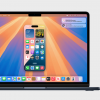By Shelly Palmer (bio), Host of WNBC's Digital Life with Shelly Palmer
I was moderating a Socratic discussion entitled, Digital 101: The Evolving Living Room at the recent Digital Sports Summit and I wanted to stir things up a bit, so I decided to ask my panel the wrong question, "Considering the amount of personal devices people are using to consume media, is there really a living room left to fight for?" Even though I asked the wrong question, Eric Anderson, VP of Content and Product Solutions, Samsung had the right answer, "We're not fighting for the living room, we're fighting for the account."
Fasten your seatbelts; this is going to get rough.
According to Mr. Anderson, Samsung, makers of exceptional consumer electronics, will sell over 8.5 million Internet connectible flat screen television sets this year. And, approximately 5.5 million of them will be broadband connected and registered online within a week or so of being purchased. This stopped me in my tracks. Peter Schwartz, Vizio, Senior Director Product Management was also on the panel, and when asked, he told us that Vizio would sell approximately 7 million Internet connectible televisions this year and they expected about 4.5 million of them to be broadband connected and registered within a week or so of purchase.
I asked if these numbers were published and publicly available, both gentlemen said they were. So let's do some back of the envelope math. Take the biggest players in flat screens: Sony, Samsung, LG, Vizio, Sharp, Panasonic, Toshiba, Sanyo, Mitsubishi, etc, and add up all the connected TV set sales expected for this year. Let's say 25 million sets that will actually be broadband connected this year. Multiply by three and up the estimate each year to account for a drop in price and increase in popularity of the services and it looks like the United States will have over 75 million broadband connected television sets fully installed by 2013.
The CEA has a different estimate as do some other research firms, but they are all higher than my little back of the envelope calculation.
Now, let this number sink in for a moment. To help you intellectualize this number, please take into account that there are about 115 million television households in the US. Approximately 100 million of them are currently cable, satellite or IPTV subscribers the remaining 15 million or so households use antennas to tune in television. More than 50% of US households are broadband connected, but that number is suspect because the FCC definition of broadband is meaningless. For this calculation you are only concerned with US households with broadband connectivity suitable for video consumption.
To help you emotionalize this statistic, remember that almost every household in America has more than one television set and the deployment of new flat screens will not be one per household. These new connected televisions will be purchased by people who have excellent broadband connectivity to their homes and can afford to purchase new flat screens — in short, the most affluent, most desirable demographic for almost every advertiser and marketer.
How will the television/cable/satellite/IPTV/Internet/Web/Video/Blu-Ray/DVD business change if the very first thing you see when you turn on your TV is a bunch of entertainment, sports, communications and news apps placed there by the Consumer Electronics (CE) manufacturer? How will they control the screen real estate? Advertising? Subscriptions to services?
Can we expect people to start asking the question, "Can I get that on Samsung?" I can't think of anything more disruptive to the business of television as it now exists.
The idea of over-the-top video (using your cable modem to watch video from the Internet instead of watching video through your cable set-top box) is not new. There are dozens of boxes such as TiVo, Roku, Vudu, Boxee and AppleTV which allow you to connect your TV to the Internet. And, as you probably know, at least one GoogleTV box is on the way. But, and it's a big but … you have to buy the box, hook it up and program it — easy for some, too inconvenient for most.

The convenience of simply plugging your TV set into your cable box and your broadband connection is unbeatable. The CE manufacturer is going to win this one and it is going to change the nature of the television business forever.
But there's more.
In my book Television Disrupted: The Transition from Network to Networked TV, I ask the question, "Who has 'the' relationship with the viewer?" The actor will say they do because they have a relationship with their fans. The show runner will say the same thing. So will the network. The advertiser will say that they have a relationship with the viewer because the viewers are buying their products — all of these answers are patently wrong. The only entity with a true relationship with the viewer is the Operator (Cable/Satellite/IPTV company) that sends the customer a bill. About 100 million households in the US have a direct billing relationship with the incumbent Operators.
Today, where there is competition for the billing relationship it is usually between Cable and Satellite companies, or between Cable, Satellite and IPTV providers (like Verizon and AT&T). These organizations fight for your account — and they fight hard. How will they fare against the new breed of competitors? A wealth of free and specialized Internet video, plus every pirated video you ever wanted with a single remote control click.
We will live in a very interesting connected world in 36 months, but nowhere near as interesting as the world imagined by one audience member. He asked … "If Samsung is fighting for the account, why doesn't it just give away HDTV's and sign everyone up? After all, you do it with phones."
Article by Shelly Palmer, host of "Digital Life with Shelly Palmer," a weekly half-hour television show about living and working in a digital world which can be seen on WNBC-TV's NY Nonstop Tuesdays at 10p Eastern and online, and the host of "MediaBytes," a daily news show that features insightful commentary and a unique insiders take on the biggest stories in technology, media, and entertainment. He is Managing Director of Advanced Media Ventures Group, LLC an industry-leading advisory and business development firm and the President of the National Academy of Television Arts & Sciences, NY (the organization that bestows the coveted Emmy® Awards). Mr. Palmer is the author of Television Disrupted: The Transition from Network to Networked TV (2008, York House Press) and the upcoming, Get Digital: Reinventing Yourself and Your Career for the 21st Century Economy (2009, Lake House Press). You can join the MediaBytes mailing list here. Shelly can be reached at shelly@palmer.net For information visit www.shellypalmer.com.






























